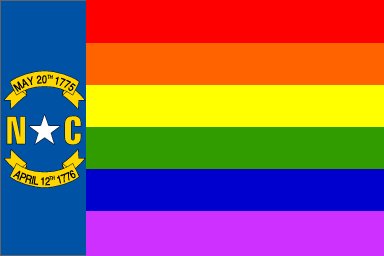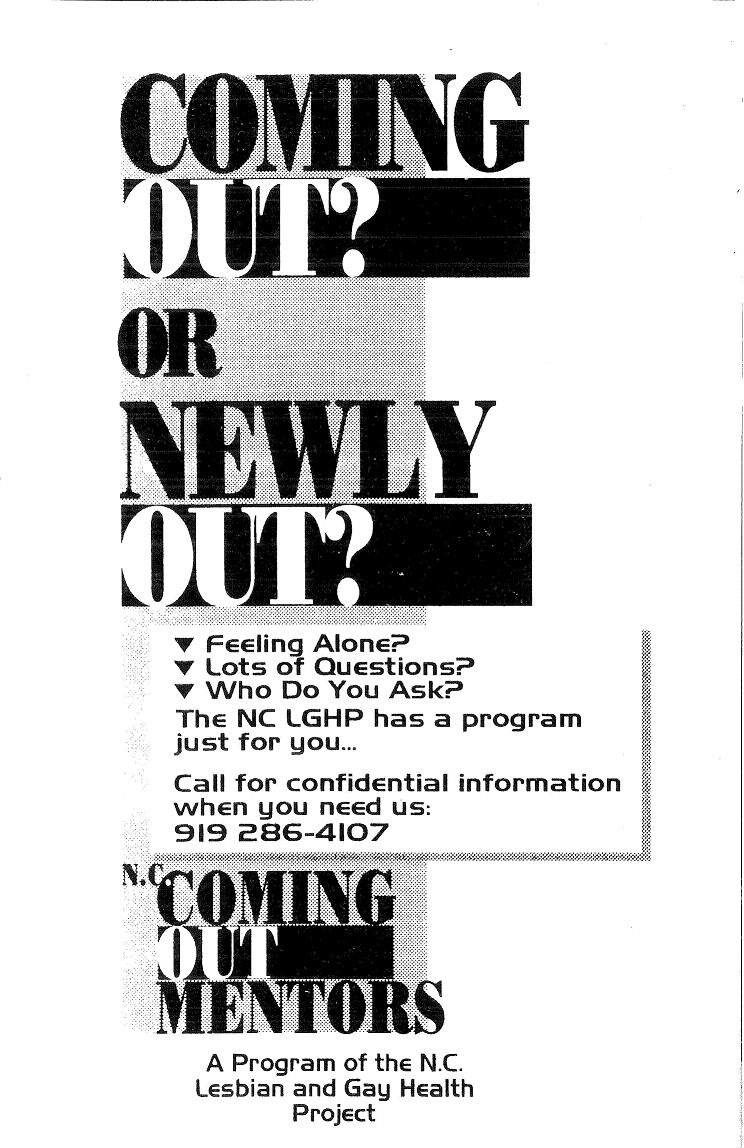Difference between revisions of "Building a Gay Network in North Carolina: The North Carolina Lesbian and Gay Health Project and Healthline"
| Line 29: | Line 29: | ||
''2012'' | ''2012'' | ||
| − | Today, the gay social network in North Carolina has migrated from the telephone lines to the web servers. Health concerns can be addressed online, and LGBT resources, in addition to being able to be found instantaneously on the websites of local organizations, have increased in number. It was the LGHP, and more specifically Healthline, that facilitated the evolution of these resources, and was a crucial step towards the development of a unified gay community in North Carolina. | + | Today, the gay social network in North Carolina has migrated from the telephone lines to the web servers. Health concerns can be addressed online, and LGBT resources, in addition to being able to be found instantaneously on the websites of [http://www.lgbtcenterofraleigh.com local organizations], have increased in number. It was the LGHP, and more specifically Healthline, that facilitated the evolution of these resources, and was a crucial step towards the development of a unified gay community in North Carolina. |
Revision as of 09:35, 21 April 2012
A Brief History
The North Carolina Lesbian and Gay Health Project (LGHP) was founded in Durham in 1982 by a group of men and women seeking to improve the quality of healthcare and the overall quality of life for the gay and lesbian community in North Carolina. After the completion of a state-wide survey, the results of which exposed numerous flaws and prejudices in the healthcare system, David H. Jolly, Carl Wittman, Timmer McBride, and Aida Wakil composed their Mission Statement: “To openly and affirmatively promote individual and community well-being of gay men and lesbians and to enhance the quality of health care through education, advocacy and service.” [2]
The operations of the LGHP were overseen by a volunteer administrative team that arranged publicity, coordinated volunteers, and secured the grants necessary to fund the non-profit organization. Finances came in from countless private donors and local organizations, and a number of larger organizations, such as the Ms. Foundation for Women and Glaxo, Inc.,[3] gave considerable sums to the program. With these funds, the LGHP was able to establish itself in the community as an invaluable resource to the gay community, particularly to men living with AIDS. As the organization grew and the demands placed upon it increased, the LGHP hired two permanent directors, Jill Duvall and Scott Hustead to serve as administrators and project coordinators. Following a debate that questioned whether her politics were a hindrance to the organization, Duvall resigned in 1990 and was replaced by Stan Holt, who was instrumental in raising awareness in and catering to the black and lesbian communities.
When Holt resigned in 1994, the LGHP began to decline. Donors withdrew, volunteer numbers faltered, and the series of directors that followed never managed to rebuild the organization. It closed in 1996, but it had served its purpose- it had facilitated the creation of a gay network in North Carolina.[4]
Goals and Services
When it was first established, the LGHP had three primary objectives- to provide healthcare referrals, education, and install an AIDS support network in the Triangle. The 459 respondents to the survey revealed that the majority of gay men and lesbians felt that they were receiving less-than-adequate medical care and/or experiencing homophobia in the healthcare system, making referrals to gay-friendly physicians a top priority. Significant funding went to health education through pamphlets and seminars, as the results also indicated that many people “lacked the information they needed to attend their health needs.”[2] The AIDS support network began to evolve through group meetings sponsored by the project, connecting those living with HIV and AIDS to understanding healthcare providers and other men in the same situation. In 1985, Healthline, a hotline for gays and lesbians to discuss health, AIDS-related issues, and LGBT issues in general was established.
Healthline
Healthline was housed in an office on 9th Street in Durham. To protect the safety of the employees and the documents in the office, the location was never disclosed, and the key was kept in Francesca’s, a nearby ice cream shop. All volunteers were obligated to go through a training program at the Orange-Person-Chatham Mental Health Center before being allowed to take calls. [5] From the first calls Heathline received, it was clear that the operation was not simply an urgent care hotline, but the beginning of a vast social network for the gay community both inside and outside the office. Many people called with AIDS-related concerns, searching for both medical assistance and support groups, but still more called for their social health and to find organizations, or just to speak with someone who was either gay or an ally of the gay community. In the pre-internet era, even gays and lesbians who were out found it difficult to meet others in the gay community. Healthline not only put callers in touch with healthcare services, but organized meetings at local churches and made callers aware of gay family events, gay and lesbian sports teams, LGBT-friendly businesses, and bars.
In turn, callers would inform Healthline of new events and organizations that they could refer others to. The constant exchange of information causes many of the archived call logs, which were also how the volunteers communicated with one another from shift to shift, to read something like a business transaction. [7] The volunteers themselves benefited equally from their time at Healthline. In an interview, R.D., who volunteered in the early 90’s, said, “I never would have known about anything if it weren’t for the hotline. We didn’t have the internet back then; I had no idea where the bars were.” After several years with Healthline, R.D. went on to volunteer at the Wake County Gay and Lesbian Helpline in Raleigh, which was established in 1991 and modeled after Healthline. [5]
Of course, not all interactions were pleasant. Heathline received several threats from homophobic callers, reinforcing the need for the secrecy of the location. Others would call in seeking sexual services, and volunteers were advised to be weary of certain numbers and told not to give out any information to certain callers.
2012
Today, the gay social network in North Carolina has migrated from the telephone lines to the web servers. Health concerns can be addressed online, and LGBT resources, in addition to being able to be found instantaneously on the websites of local organizations, have increased in number. It was the LGHP, and more specifically Healthline, that facilitated the evolution of these resources, and was a crucial step towards the development of a unified gay community in North Carolina.
- ↑ Image courtesy of http://www.homohealth.org
- ↑ 2.0 2.1 1982 LGHP Informational Brochure, courtesy of NC Lesbian and Gay Health Project Archives 1982-1996, Rubenstein Rare Book & Manuscript Library, Duke University
- ↑ LGHP Financial Correspondence Letters, courtesy of NC Lesbian and Gay Health Project Archives 1982-1996, Rubenstein Rare Book & Manuscript Library, Duke University
- ↑ Lekus, Ian K. "Health Care, the AIDS Crisis, and the Politics of Community: The North Carolina Lesbian and Gay Health Project, 1982-1996." Modern American Queer History. Ed. Allida M. Black. Philadephia: Temple UP, 2001. 227-252. Print.
- ↑ 5.0 5.1 R.D. Personal Interview. 21 March 2012.
- ↑ 1995 Coming Out Mentoring Brochure, image courtesy of NC Lesbian and Gay Health Project Archives 1982-1996, Rubenstein Rare Book & Manuscript Library, Duke University
- ↑ Call Logs 1991-1995, courtesy of NC Lesbian and Gay Health Project Archives 1982-1996, Rubenstein Rare Book & Manuscript Library, Duke University
Kyle Flannelly is a Psychology and French Major at the University of North Carolina at Chapel Hill.

